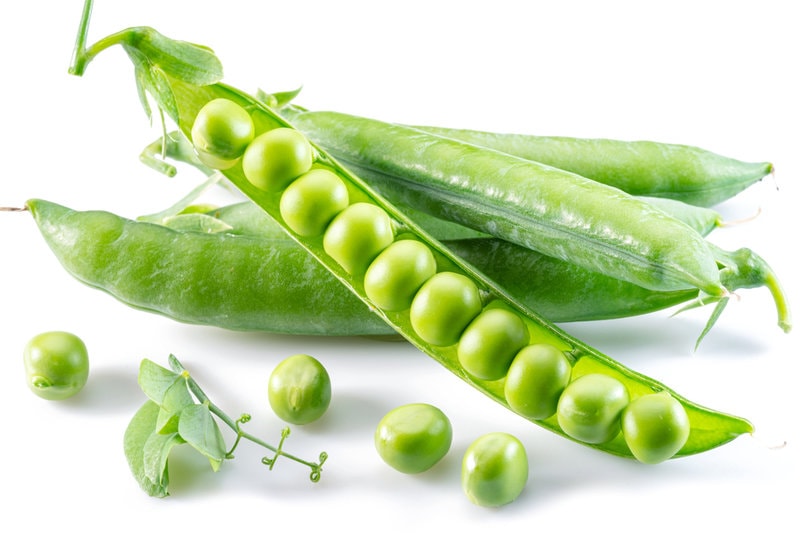For the last decade, dog owners have been more careful about what they feed their canine companions. Some have witnessed their furry friends react to certain food negatively, so they avoid giving their dogs those foods altogether. The question, “Can my dog eat this or that?” often arises. One such question may be, “Can dogs eat green peas?”
Yes, dogs can eat green peas because they are nutritious and healthy. Fresh green peas, and other kinds of peas, are suitable for pooches. However, the American Kennel Club strictly warned against giving dogs canned green peas due to the preservatives added to extend the shelf life.
Dogs get major nutrients like fat and protein from meat, but vegetables like green peas also greatly benefit your pooch. So next time you treat your canine companion, consider it a vegetable. This article reviews the benefits of green peas, the safe kinds of green peas for dogs, and why, for some dogs, green peas may cause problems. First, let’s see if dogs can eat cooked green peas.
Can Dogs Eat Cooked Green Peas?
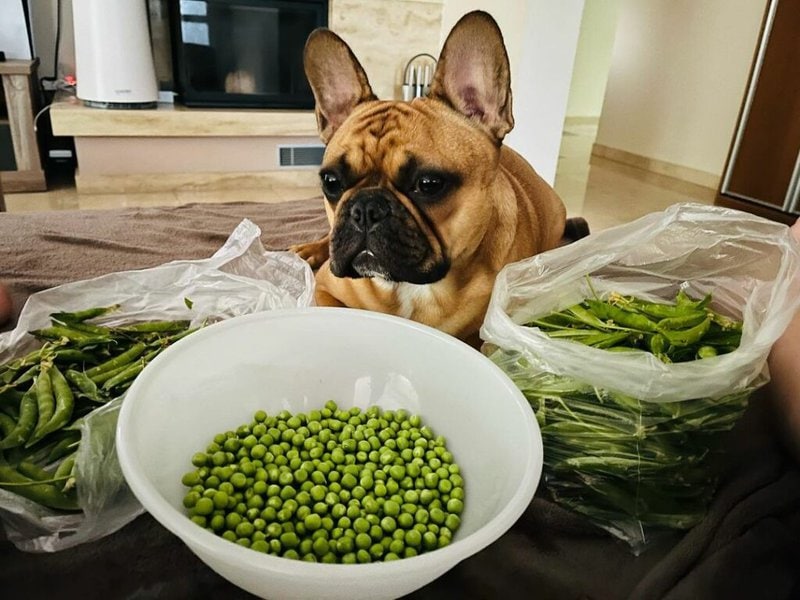
Yes, dogs can eat cooked green peas. Cook the green peas lightly to soften their coats. Green peas are high in fiber and essential vitamins. The fiber in green peas can help with your dog’s indigestion and constipation.
How Many Green Peas Can I Give My Dog?
Moderation is the keyword here. For small-to-medium-sized dogs, serve one teaspoon of green peas. Larger dogs can have one tablespoon of green peas.
Remember, your dog’s diet shouldn’t consist of only green peas, which are a treat. For treats, keep the serving size small. Too many green peas can cause flatulence, bloating, or diarrhea for dogs.
Every pet parent should know the 10% rule: 90% of your dog’s daily calories should come from complete dog food. For the remaining 10%, you are free to feed your pup treats or other healthy snacks.
Consult your veterinarian before giving dogs green peas. If your pooch has not tried green peas before, give one or two and then watch for allergic reactions or problems. In case of illness, take your pooch to a vet.
Can Green Peas Upset A Dog’s Stomach?
Some dogs are allergic to legumes like green peas. Too many green peas can upset dogs’ stomachs because their digestive tracts do not absorb vegetable matter well.
So if dogs eat too many green peas, they may experience gas, bloating, or diarrhea as their digestive system processes them. Moderation is key. Give one teaspoon to small-to-medium dogs and one tablespoon to larger dog breeds.
If your canine companion has kidney problems, do not feed them green peas.
Why Do Dogs Eat Green Peas?
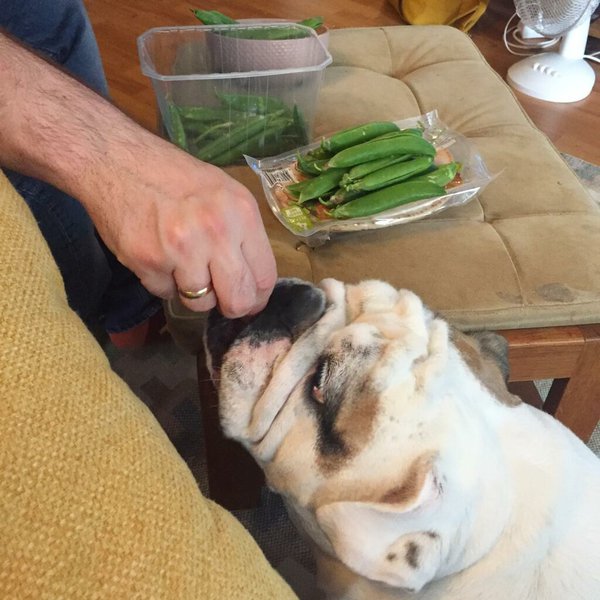
Though dogs are omnivores, they have learned to eat fruits and vegetables too. Dogs may not need vegetables as humans do, but vegetables like green peas can help provide your dog with a well-balanced diet.
Green peas contain the following nutrients:
- Fiber
- Carbohydrates
- Vitamin A
- Vitamin K
- Protein
- Thiamine
- Folate
- Manganese
- Iron
- Phosphorus
- Zinc
Fiber
Many people think of fiber as mere filler, but that is incorrect. Fiber maintains a healthy digestive system. Dogs need fiber because it helps the gastrointestinal tract operate smoothly and efficiently.
Dogs depend on fiber in their diet. Some pet foods have considerable amounts of fiber. A good amount of fiber promotes doggies’ healthy bowel movements.
Prebiotic fiber is a good energy source for large intestine cells. Fiber also helps stop the growth of potentially harmful bacteria and increases beneficial bacteria.
Veterinarians often recommend high-fiber food when your pooch is having digestive problems, diarrhea, or constipation.
Carbohydrates
Usually, carbs make up 30% to 70% of most dry dog foods. Adding green peas can ensure your furry friend eats enough carbs. Carbohydrates are very important to dogs’ health because they help give your dog energy.
Dogs with low energy don’t play or enjoy walks like dogs with high energy. Your pup’s body needs glucose. Carbs contain glucose to necessitate the functioning of a healthy brain and proper nervous system.
If your canine companion isn’t getting enough glucose, add green peas to help energize your dog. Green peas are starchy vegetables that are high in complex carbs.
Vitamin A
Dogs need vitamin A for healthy growth and development. As a puppy, your dog relied on its mother’s breast milk for a healthy dose of vitamin A.
Vitamin A is a fat-soluble vitamin stored in the liver until the body needs it. But pooches don’t have the liver-storage abilities of humans. Dogs rely on their food for vitamin A.
Vitamin A also helps strengthen the immune system and boost your dog’s vision. A vitamin A deficiency may cause vision problems for your fur buddy.
Vitamin A deficiency can also cause younger doggies to experience lower growth rates, weak bones and muscles, and unhealthy skin and hair.
Green peas are a great vitamin A supplement, so give your dog green peas to help their growth and development.
Vitamin K
Vitamin K helps heal wounds and benefits bones. Since dogs do not make their own vitamin K, green peas serve as a vitamin K supplement for dogs. But you have to make sure their diet supplies enough of it.
Dieticians observe that vitamin K reduces allergic reactions in both humans and dogs.
Some other benefits of vitamin K follow:
- Maintains healthy bone structure
- Metabolizes calcium in bones
- Promotes blood coagulation
- Helps quick wound recovery
- Prevents anemia
For doggies, a vitamin K deficiency can cause depression, lethargy, anemia, gum bleeding, and bleeding under the skin.
Protein
Dogs need protein and fat most in their daily diet. Meat is not the only source of protein; vegetables and legumes like green peas also contain protein.
Protein helps your canine buddy to have healthy fur and skin. Protein also helps your doggie develop strong muscles and quickly repair muscle damage.
In your dog, protein helps carry out several important functions:
- Developing and maintaining healthy cells and tissue (e.g., skin, muscle, bone, hair)
- Boosting the immune system
- Generating hormones, antibodies, and enzymes
- Providing a source of calories
Green peas are high in protein and serve as a very useful supplement for doggies.
Minerals
The important role of minerals in a pooch’s body cannot be overstated. Minerals help coordinate many body functions, so your dog can carry out normal daily activities.
There are several types of minerals in green peas: zinc, manganese, phosphorus, and iron.
Minerals help your dog’s body function in many ways:
- Form bones, nerves, muscles, and cartilage
- Regulate transportation of oxygen in the bloodstream
- Produce hormones
- Maintain bones and teeth
- Strengthen the immune system
- Improve skin and coat health
- Aid in protein digestion
A mineral deficiency can lead to bone deformities or weakness.
Why Can’t Dogs Have Green Peas?
Some dogs can’t have green peas because they suffer from kidney problems or legume allergies.
Can Dogs Eat Green Peas And Rice?
Absolutely! Yes, rice is one of the most consumed foods in the world. Both humans and animals love rice. Occasionally, commercial dog food makers include rice in their recipes.
Mixing white rice with green peas is a good idea for creating a balanced diet for your furry buddy. Dogs receive carbs, protein, and other necessary vitamins from a snack of rice and green peas. The same 10% caloric rule applies when serving dogs rice.
However, avoid feeding brown rice to your dogs. It is more difficult for dogs to digest.
White rice is a source of carbohydrates for pooches. Rice helps stabilize your canine buddy’s stomach when ill because rice is low in fiber and easy to digest.
Can Green Peas Cause Heart Problems For Dogs?
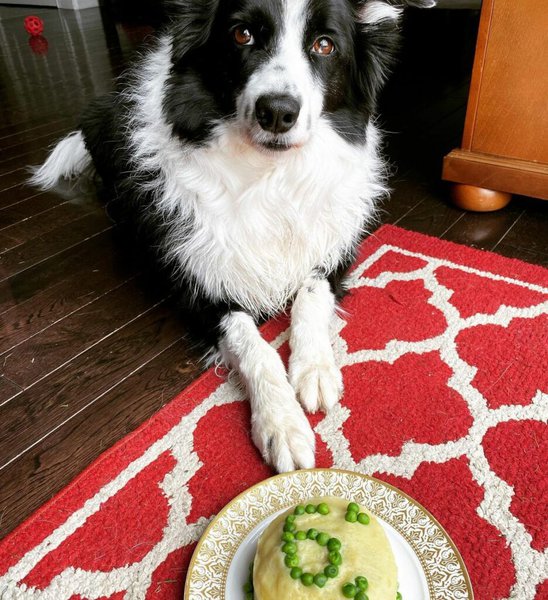
There isn’t conclusive evidence for whether green peas cause heart problems in dogs. There is evidence that green peas benefit dogs, though too many may cause stomach problems like diarrhea.
In 2021, researchers at Tufts University published a study reporting that green peas are a leading food item contributing to the increase of diet-associated heart disease (DCM) in dogs.
The US Food and Drug Administration (FDA) has also researched this, concluding that green peas and lentils are common foods associated with DCM in dogs.
Currently, we do not know how responsible grain-free foods are for causing heart problems for our furry friends. So it is best to give green peas as treats only on occasion and always in moderation.
Green peas should not be your dog’s main source of food. Visit your veterinarian for further directions about feeding green peas to your canine companion.
Can Dogs Eat Cooked Green Peas?
Yes, dogs can eat cooked green peas.
What Type Of Green Peas Can You Give Your Dog?
Dogs can eat any type of green pea. Garden or English peas, sugar snap peas, petit pois, and snow peas are different types of green peas you can feed your four-footed companion.
Do not add any seasoning to green peas when feeding dogs. Certain ingredients safe for people are not suitable for dogs. Onions, garlic, and butter would make your furry friend sick.
The best way to serve green peas to your dog is to cook lightly and serve them plain. Cooked green peas are softer and easier for dogs to eat. The same method applies to serving dogs green peas in a pod.
Thawed
Thaw frozen green peas before feeding them to your furry friend. They carry the same nutrients as fresh and frozen green peas.
Thawing is fast and convenient. It is as simple as removing the green peas from the freezer and allowing them to thaw for a few minutes until they reach room temperature. Rinse and serve to your pooch.
Fresh
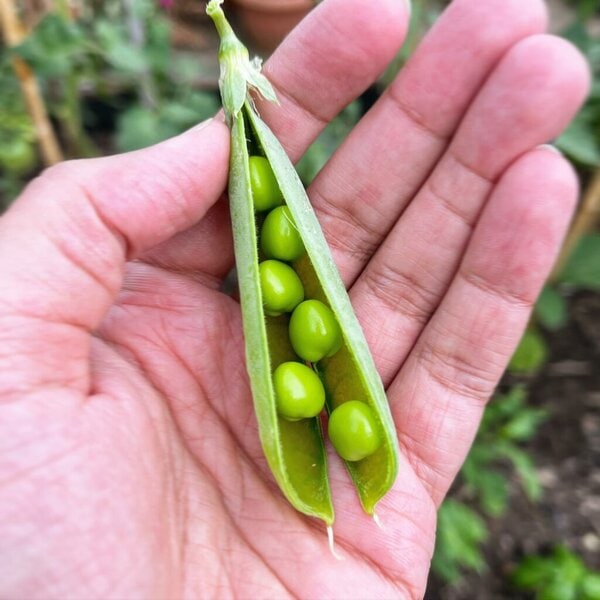
Fresh vegetables are always best. Fresh green peas contain natural sugars, which easily convert to starch. It is the easiest and fastest way to serve green peas.
Your pooch’s digestion may benefit if you cook fresh green peas before serving. Your dog’s intestines will break them down more easily. Fresh sugar snap peas with their pods are easier for dogs to digest.
Frozen But Not Canned
Dogs can eat frozen green peas but not canned green peas. Thaw or cook frozen peas before serving them to your furry friends. Frozen peas generally taste better and are sweeter than fresh peas.
A 100-gram serving of frozen green peas contains about 84 calories, with 78% water, 16% carbohydrate, 5.4% protein, and hardly any fat (0.2%).

